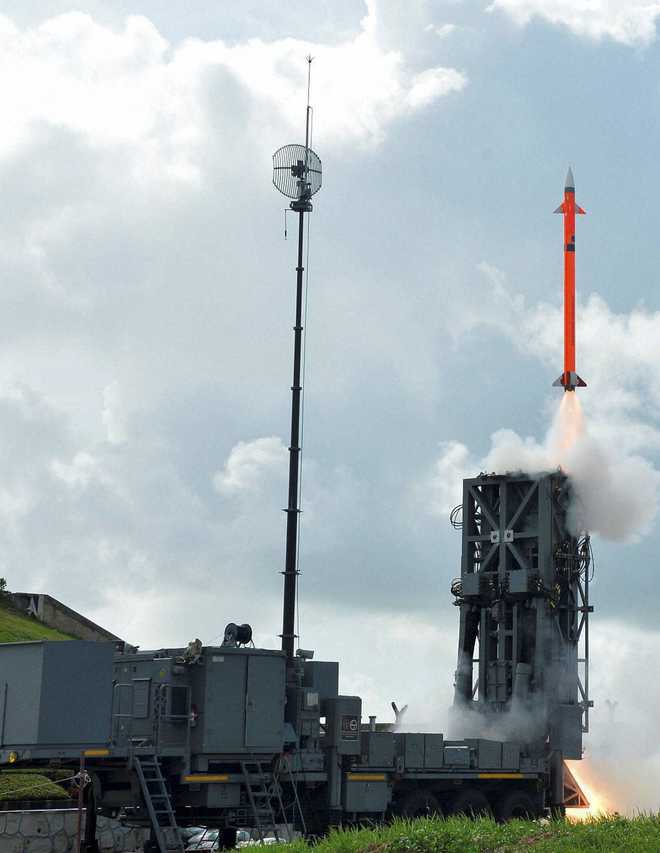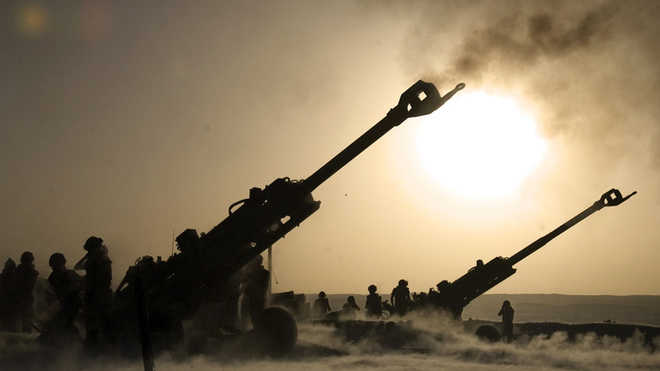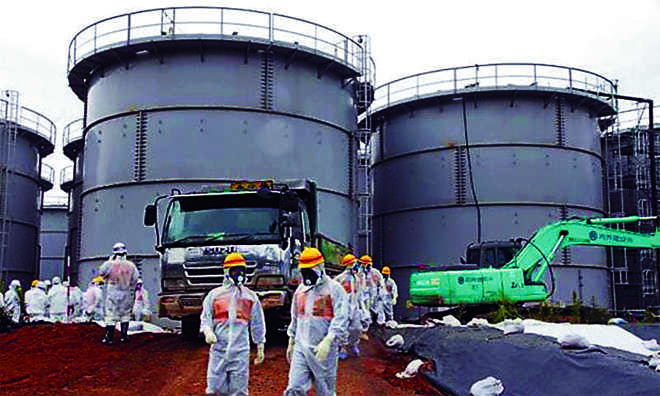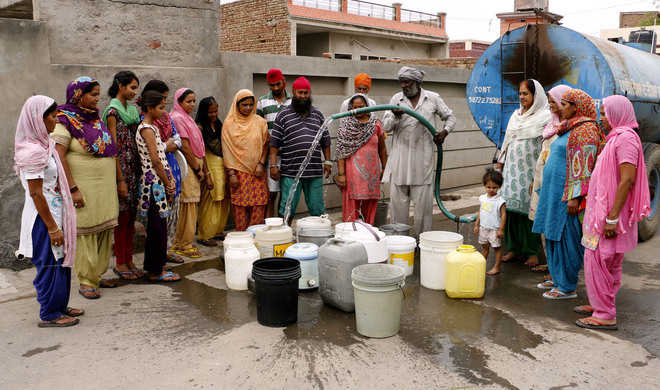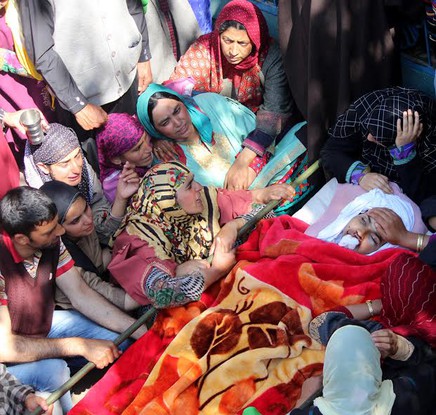Punjab economy grounded by overstay in agriculture..Lakhwinder Singh
The political leadership’s lack of vision is reflected in not taking any measures to shift the economy in Punjab from agriculture to higher stages of economic development.
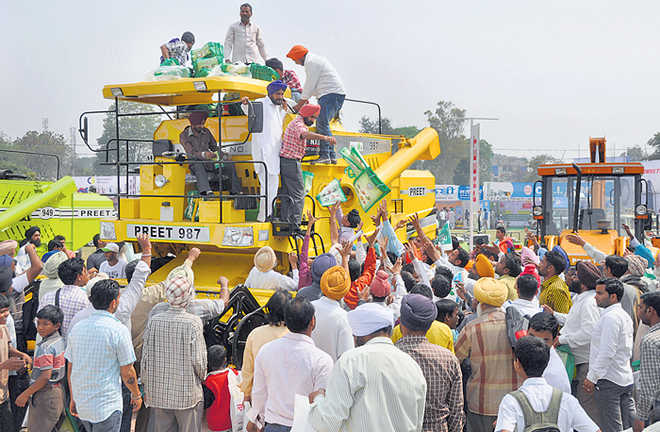 Farmers jostling to catch an empty jute bag during the PAU Kisan Mela. Tribune photo
Farmers jostling to catch an empty jute bag during the PAU Kisan Mela. Tribune photoAgriculture innovations and its application in Punjab have catapulted the fortune of rural population since the mid-1960s. The rate of yield increases was very high. In the case of paddy, the yield increased from 1009 kg per hectare in 1960-61 to 3952 kg per hectare in 2013-14. Punjab’s traditional crop, wheat has shown higher increments in the increases in yield nearly four times due to multidimensional innovations regarding seed varieties, marketing and institutional arrangements. The long-drawn investment in agriculture in the post-Green Revolution period generated specialisation and agricultural capabilities evolved. This resulted in attaining a per capita income which was highest in major Indian states. The agriculture sector of Punjab not only fulfilled the deficiency of food grains production and provided much-needed food security to the nation but was an engine of growth of Punjab economy. Agriculture sector generated substantial surpluses and through forward and backward linkages spurred all-round economic development. There emerged small-scale agriculture implements industry, transport and services, along with social infrastructure and spread of health and education in Punjab. This model of capitalist development was driven by public investment and state support. The focus was on higher production targets. The food grains produced in Punjab continued to be useful to maintain food stocks in the country when rain-fed agriculture states were facing drought. Food production in the food-deficit states has been increasing and that has reduced the importance of Punjab’s food grain production. Due to uncertainty of weather conditions, the assured and stable food grains supplies of Punjab continue to serve the nation. The signs of agricultural crisis in Punjab emerged in the late 1970s and there was a full-fledged crisis in the early 1980s, reflected in the slowdown in agriculture productivity and farmers’ income. Apart from technological constraints, the long-run sustainability of Punjab food grains dominated agriculture production was questioned on the ground of over-exploitation of land and ground water resources. The rising cost of cultivation and falling returns caused deep distress and suicides of farmers and agricultural labour. Instead of reducing dependency of the workforce on agriculture, the absolute number of agriculture workforce has increased, due to the lack of economic transformation and low industrialisation. Agricultural economists and policy makers have also understood the gravity of the situation and suggested diversification from low value-added to high value-added agriculture. This strategy failed to provide the impetus due to faulty design, unsustainable rganisational arrangements and government apathy. The overstay of Punjab economy in agriculture has specificities ingrained in the nature of polity, public policy and locational factors. In post-Partition Punjab, the political leadership envisioned Punjab as a fertile ground for agriculture development. It developed and implemented public policy for promoting agriculture production as the top priority. Food shortages were seen as a hindrance in the process of industrialisation strategy adopted by the Centre. Since the Congress party was dominant in Punjab’s political scenario, the emphasis on agriculture investment and solving the nation’s problems was the fundamental priority. When the Congress was replaced by the Shiromani Akali Dal in alliance with the Jan Sangh and leftist parties in 1967, Punjab entered an era of political instability due to successively short-lived governments. As and when the political leadership faced problems related to the stagnation of structural transformation of the Punjab economy, they diverted attention by raising religious concerns and movements against long-pending issues such as territorial disputes, transfer of Chandigarh as the state capital and river water-sharing. This was suitable even for the Congress party at the Centre. Together, both parties pushed Punjab into turmoil in the late 1970s and early 1980s.Punjab economy has thrown challenges before the political leadership of the state but leaders perfected the art of side-tracking the main issue of economic transformation and successfully curbed the positive social democratic movements that were posing a challenge by bringing the main issue to the fore. Even during the post- liberalisation period and restoration of democratic rule, Punjab remained in same mode of production structure. It could not correct the chronic deficiency of investment in the state. Wheat-paddy rotation was perpetuated. Despite democratically elected governments, public policy that perpetuates the existing production system remains. The lack of vision and will of the political leadership in economic transformation continued in not taking any long-term and short-term measures to shift the economy from agriculture to higher stages of economic development. This, the fundamental cause of overstay of Punjab in an agrarian economy, has disastrous consequences. There are other historical factors such as a long border (553 km) with Pakistan. Continuous threat of war and actual wars of 1965 and 1971 have generated a situation not conducive for heavy industrial investment. The recent order to clear the 10 km area adjoining the border with Pakistan shows disturbed conditions and instability for entrepreneurs. The licensing policy and equity concerns of the Centre have also played an important role of non-location of public industrial enterprises in Punjab. This kind of argument is also supported in a recent study by Montek Singh Ahluwalia, a prominent policy maker, that provides evidence of transfer of fewer resources to states such as Punjab. The rent-seeking behaviour of both the political leadership and bureaucracy has made Punjab unfriendly for industrial investment both of the diaspora and private corporate sector. These factors combined together played an important role to discourage industrialisation in Punjab, despite having created favourable conditions based on high productivity agriculture and generated enough investible surpluses. The writer is Professor of Economics, Punjabi University, Patiala
Why the Centre does not want Punjab to diversify
There is critical reliance on Punjab’s rice production for India’s food self-sufficiency. This is what is preventing the Centre from taking any strategic decision to incentivise Punjabi farmers to move away from rice cultivation.
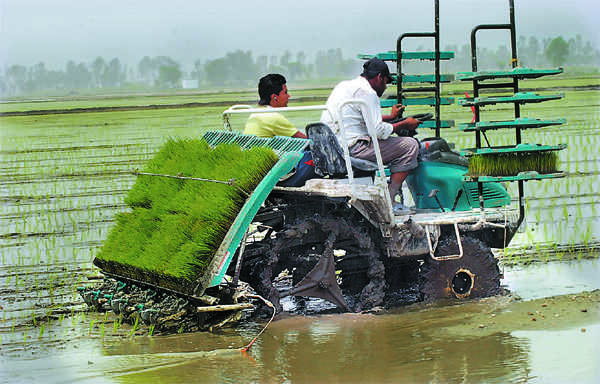 A Japanese paddy transplanter at work near a village in Mehatpur, Jalandhar.
A Japanese paddy transplanter at work near a village in Mehatpur, Jalandhar.WITH the paddy transplanting season approaching in Punjab, there will be focus again on the ecological necessity of reducing the area under rice cultivation. The past history of cultivation of rice, a water-guzzling crop, and water scarcity in Punjab make crop diversification especially salient. The area under rice cultivation in Punjab was only 285 thousand hectares in 1966-67 at the time of the launch of the Green Revolution strategy. India was then a food-deficit nation, dependent upon the humiliating PL-480 food aid from the US. Indira Gandhi had characterised the aim of achieving food self-sufficiency through the Green Revolution strategy a matter of “national survival”. By 1970-71, this “national survival” strategy had led to area under rice cultivation in Punjab rising to 390 and by 1975-76 to 567 thousand hectares. Area under rice cultivation further increased in 1980-81, 1985-86, 1990-91, 1995-96, 2000-01, 2005-06, 2010-11, 2011-12, 2012-13 and 2013-14 to 1178, 1714, 2024, 2161, 2611, 2642, 2831, 2818, 2845 and 2851 thousand hectares respectively. In 2014-15, this jumped to 2894 thousand hectares. Within a time span of 50 years (1966 to 2015), the area under rice cultivation in Punjab has increased phenomenally by over 10 times. This is one of the most startling changes in land use observed in agrarian history anywhere. This exponential increase has resulted in the ground water levels in Punjab going down drastically. As of 2011, out of the total 138 blocks in Punjab, 110 are overexploited, four are critical, two are semi-critical and only 22 are safe. Thus, 84 per cent of the blocks are either overexploited, critical or in a semi-critical category and only 16 per cent are safe. As per the Central Ground Water Board, Punjab has the highest stage of ground water development of 172 per cent amongst all the states in India. This is a scary index of the ground water status of Punjab. The ground water development stage of 100 per cent indicates that ground water consumption is equal to ground water recharge; ground water development stage of above 100 per cent indicates that the annual ground water consumption is more than the annual ground water recharge. A very high stage of ground water development of 172 per cent indicates that the annual water consumption in Punjab is very high compared to its annual recharge. An additional aspect of Punjab’s water vulnerability is that the ground water availability for future irrigation use for Punjab is not only lowest of all the states; it is, in fact, negative (-14.83 billion cubic metre) as per the 2011 data. If despite the grave situation of current and future water availability in Punjab, diversification away from rice has not taken place, we need to explore the reasons. One, the assured price and procurement of rice incentivises farmers to stick to rice cultivation. Reasons preventing diversification are lower economic returns from alternative crops and the lack of reliable and proven technology for growing such crops. These factors are derivatives of the strongest reason behind the failure of crop diversification, namely that the central government is strategically opposed to crop diversification in Punjab due to India’s critical reliance on Punjab agriculture to meet the national consumption needs for rice.According to the available data, rice consumption in India in 2010-11, 2011-12, 2012-13, 2013-14 and 2014-15 was approximately 90000, 94006, 95193, 96404 and 97073 thousand tonne, respectively. As per the data from the Ministry of Agriculture and Farmers’ Welfare, the demand for rice in the years 2016-17 and 2020-21 is estimated to be 110 and 117 million tonne. respectively. The supply of rice for the year 2016-17, however, is estimated to be 98-106 million tonne, indicating that India will be just marginally able to fulfil its rice needs. Another study estimates the demand for rice in the years 2020 and 2030 to be 111.8 million tonne and 122.4 million tonne and the supply to be 108.1 and 122.1 million tonne, respectively. This highlights that there could be a supply gap of 3.7 and 0.3 million tonne, respectively for the years 2020 and 2030. Any central government, under such circumstances, would be opposed to the diversification of Punjab agriculture away from rice. Keeping in view India’s population size and consequently the demand for rice, India always requires sufficient stock of rice. The production of rice in Punjab for the years 2010-11, 2011-12, 2012-13, 2013-14 and 2014-15 was 10837, 10542, 11374, 11267 and 11107 thousand tonne. The 2013 agriculture policy of Punjab states that the area under rice is 28 lakh hectares. It was targeted to move 16 million hectares away from rice in the coming years. However, contrary to this target, the area under rice for the years 2012-13, 2013-14 and 2014-15 has continuously increased to 2,845, 2851 and 2894 thousand hectares, respectively. If an area of 16 lakh hectares as proposed is moved away from rice, it will mean a decrease in production of rice to the tune of approximately 6,193 thousand tonnes per year (calculated on the basis of average rice yield of the last five years from 2010-11 to 2014-15). If Punjab diversifies away from rice; the rice stocks of India could be dangerously hit.India could possibly build buffer stocks with cheaper rice imports but instability in the international rice market makes such import reliance a risk-prone strategy. Also, India can cover for the shortfall in buffer stocks by curtailing its rice exports. Even then the rice stocks would approach critical limits and a precarious situation may arise for India. The critical reliance on Punjab’s rice production for India’s food self-sufficiency in general and rice in particular prevents the Centre from taking any strategic decision to incentivise Punjabi farmers to move away from rice. This imperative must force the state government and other stakeholders to realise that a Punjab-based strategy to diversify away from rice has to be devised for Punjab’s ecological survival. Of course, without expecting policy support from the Centre to reduce rice production in Punjab. Pritam Singh is Professor and R Singh a PhD student in Economics at Oxford Brookes University, UK
Illusion of surplus Ravi-Beas waters
K.S. Pannu
Like a division of assets in an agrarian feudal family where everything has to be divided equally, Haryana insisted on an equal division of river waters. It was oblivious of laws of nature which determine the flow and use of river waters on a riparian basis and not on the whims of partisan elders.
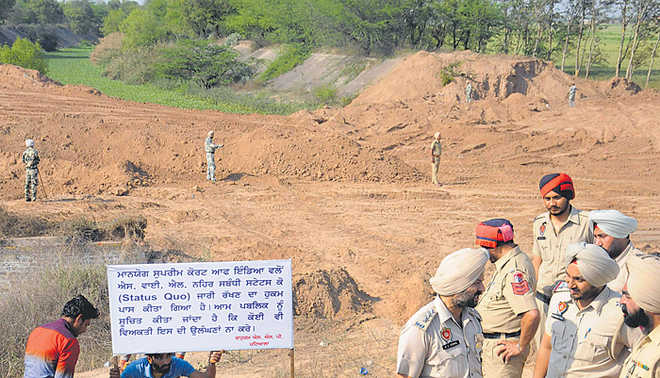 Where’s the water: The public notice states the SC order on maintaining status quo and barring any activity. A tribunal for reallocation of waters must be constituted. Tribune photo
Where’s the water: The public notice states the SC order on maintaining status quo and barring any activity. A tribunal for reallocation of waters must be constituted. Tribune photoHistory gets distorted when it is not explained in the right perspective and factually. Since November, 1954, when the Government of India called upon irrigation engineers of the then joint Punjab to devise plans to utilise the surplus waters of Ravi and Beas, much water has flown down both the rivers. The engineers of joint Punjab could work out plans to utilise only 7.25 out of 15.85 MAF surplus waters of both the perennial rivers flowing down to Pakistan, keeping in view the prevailing cropping pattern. In a meeting held on January 29, 1955, convened by Gulzari Lal Nanda, the then Union Water Resources Minister, and attended by Irrigation Minister, Punjab, Chaudhary Lahiri Singh from Sonepat, the Centre allocated 7.20 MAF water to Punjab as per the plan presented before them. Rajasthan was allocated 8 MAF and 0.65 MAF was given to Jammu and Kashmir. Unfortunately, the written plan put up by joint Punjab before the Centre showed only 0.62 MAF water shall be utilised in present-day Haryana area through the Hansi Canal (0.32 MAF) and through the Bhakra Canal (0.30 MAF). Rest of the 6.63 MAF surplus water and the pre-Partition usage of 1.98 MAF was proposed for utilisation in present-day Punjab as follows: Upper Bari Doab Canal (3.17), Shah Nehar (0.79), Bet Area of Ravi Beas (0.23), Sirhind Feeder (2.79), Eastern Canal (0.71), Chakandher Tract (0.24), PEPSU area through Bhakra Canal (0.68). In case Chaudhary Lahiri Singh, the illustrious son of Haryana, had shown the need and capacity of south-east Punjab (now Haryana) to utilise 3.50 MAF water, as is now being demanded, the Centre would have allotted 10.70 MAF water to joint Punjab, instead of 7.20 MAF,. Rajasthan was not interested in utilising surplus water but was forced to utilise the balance surplus of 8.00 MAF to justify before the World Bank team that India could utilise the entire surplus water of the three eastern rivers. With the allocation of surplus Ravi-Beas water by the Centre as per proceedings of the meeting of January 1955, the World Bank was satisfied about India’s claim on three eastern rivers. Haryana, the reorganised state, got dissatisfied over the internal distribution of this surplus water. It got allocated 3.50 MAF water as per December 1981 agreement, instead of the 0.62 MAF approved by GOI in 1955. Incidentally, the Malwa region of present Punjab constituting 65 per cent area which got only 0.60 MAF water by the 1955 order of the Centre is still getting only that quantity. Not even a drop of more water was allocated to it after 1955. Malwa is the worst sufferer of depletion of ground water table. As per the provision of section 78 of the Punjab Reorganisation Act 1966, Haryana is to get the water of Beas as per the “Purpose of project”. The “Purpose of project” mentioned in Beas project report clearly stipulates that Haryana areas will get only 0.90 MAF water. As against this, Haryana is actually utilising 1.62 MAF water against the spare capacity available in the Bhakra Main Line Canal. Reasons of discontent of Haryana were political rather than logical. Like division of assets in an agrarian feudal family where at the time of partition everything has to be divided equally, Haryana insisted on equal division of river waters, oblivious of laws of nature which determine the flow and use of river waters on a riparian basis and not on the whims of partisan elders to support the younger son. C.B. Singh Sheoran, former Chief Engineer of Haryana tells us (The Tribune April, 12) that Punjab may not be aware that Himachal is an upper riparian state and what will Punjab do if it starts dictating terms. Punjab knows that not only is Himachal an upper riparian state to Sutlej, Beas and Ravi rivers but Jammu & Kashmir is an upper riparian state of river Ravi. It is clearly known that Punjab is a lower riparian state of all the three rivers and Haryana and Rajasthan do not even fall in the distant definition of riparian states. The author obliquely admits this. Punjab’s political leadership has declared that the state will not share even a drop of water, because Punjab has none to spare. The rain and ice flakes falling outside Punjab constitute rivers which flow through the territory of Punjab. Not even a drop of such water flows through the territory of Haryana. Punjab has prior right of usage of such water, along with other riparian states (HP and J&K). The allocation of 4.65 MAF of Yamuna waters to Haryana as a result of the agreement amongst five states is a reality and not an illusion. Punjab has time and again stressed upon the need to build storages/dams for full utilisation of the allocated Yamuna waters. Instead of spending a huge sum of money over the construction of the SYL Canal, for long-distance transfer of Ravi-Beas waters to the Yamuna basin of Haryana, which would cause disruption of water already being used by Punjab farmers in Ravi-Beas areas, the amount should be spent on constructing storage dams on the Yamuna. This would adequately fulfil the requirement of Haryana. The position that Yamuna water allocations to Haryana should have no bearing on the distribution of Ravi-Beas waters, is self-defeating. Why should Yamuna waters which formed an asset of joint Punjab before reorganisation, be earmarked for the exclusive usage of Haryana, when Haryana has been entitling itself to waters of Ravi-Beas on an equal footing with Punjab.It is wrong to say that Punjab farmers prefer tubewells than canals for irrigation. River water allocations to Punjab, out of the total availability of water in the three rivers (34.34 MAF), is only 14.22 MAF — including protected pre-Partition utilisation of 4.55 MAF of Sutlej waters, 1.48 MAF of Ravi waters and 0.50MAF of Beas waters. Due to the meagre allocation of river waters, agriculture in Punjab, perforce, became dependent upon tube well irrigation. Not only in Punjab, but also in other states including Haryana, water requirement is comparatively higher during paddy plantation. It is wrong that only a nominal quantum of water is needed thereafter.It is an established fact that the quantum of surplus Ravi-Beas waters has decreased to 13.38 MAF based on 1981-2013 flow series instead of 17.17 MAF as estimated earlier. Punjab had, as far back as 2003, requested the Centre, as per provisions of the Inter-State River Water Disputes Act, 1956, to constitute a tribunal for reallocation of waters. On a pro rata basis applied to available water as per 1981 agreement, for argument’s sake, Haryana’s share works out as 2.95 MAF, instead of 3.50 MAF. After taking into account the existing utilisation of 1.62 MAF through the existing BML Canal by Haryana, the dispute has been relegated to 1.33 MAF water. By the Yamuna agreement of 1994, Haryana is to get 2.01 MAF additional water from Yamuna, over and above the usage of 2.64 MAF at the time of reorganisation of Punjab in 1966. This means Haryana will end up getting 30 per cent more water from Yamuna, than its demand from Punjab. The Haryana viewpoint that Punjab farmers are happier pressing the button of tubewell than waiting for the wari (turn) of canal supply and that Punjab canals even do not have proper water course to supply water to farms, is not only wrong reading of situational position but also smacks of disdain towards Punjab farmers. Hence, Haryana should invest financially and politically to utilise 2.01 MAF of Yamuna waters rather than looking at 1.33 MAF of illusionary water from Ravi-Beas. The writer, an IAS officer, is the acting Vice Chancellor of the IK Gujral Punjab Technical University, Jalandhar
CM seeks package for industrial, farm sectors
 Chief Minister Capt Amarinder Singh (right) with Union Minister of Urban Development Venkaiah Naidu in New Delhi on Wednesday. Tribune Photo
Chief Minister Capt Amarinder Singh (right) with Union Minister of Urban Development Venkaiah Naidu in New Delhi on Wednesday. Tribune PhotoRavi S Singh
Tribune News Service
New Delhi, May 17
The NITI Aayog will visit Punjab to discuss with the state government issues relating to development of the state. Chief Minister Capt Amarinder Singh was assured of this when he called on NITI Aayog vice-chairman Arvind Panagariaya to seek central help for state’s development, including its industrial and farm sectors. The date of the visit is yet to be finalised.The Aayog assured measures for the development of the state through programmes such as crop diversification and industrial revival.Allaying Amarinder’s concerns, Panagariaya said Punjab would not be impacted by the Centre’s industrial incentives to Uttarakhand, Jammu and Kashmir, and Himachal.Amarinder urged for a special industrial package for the state along a 40-km belt in the sensitive border area. He made a case for encouraging micro, small and medium enterprises with similar incentives in border belt and the sub-mountainous area along the hilly tracts.He suggested the development and maintenance of border roads under the country’s national highway programme.He sought the promotion of a petro chemical hub adjoining the Bathinda refinery for manufacturing value-added products.Amarinder urged for financial support to bail out farmers reeling under financial distress, and encouragement to agro food parks, especially in horticulture.Price deficiency support for maize and other crops, as per the MSP, in addition to wheat and paddy, one-time waiver and debt swap by the Centre of the term loan taken by the state were also sought.Other demands included support in planning and implementing micro-irrigation system. Besides, the Chief Minister suggested the Centre to acquire land located beyond the border fence and compensation for lands damaged or rendered ineffective for farming due to periodic military deployment.He sought inclusion of Punjab in category “A” state for financial assistance on the pattern of Jammu and Kashmir and the north-eastern states under the modernisation of the state police forces scheme with central funding on 90:10 basis.
‘Will have central projects on track’ Chief Minister Capt Amarinder Singh met Union Minister Venkaiah Naidu in New Delhi on Wednesday and assured state’s commitment to implement the Real Estate Regulatory Act and to ensure that all Central projects related to poverty alleviation funded during the previous regime in the state are brought on the track and executed at the earliest. Naidu said he would visit Punjab next month to review the progress of the central projects.
Central team to visit state
- NITI Aayog vice-chairman Arvind Panagariaya assured Chief Minister Capt Amarinder Singh that Aayog members would visit Punjab
- On agenda will be matters related to development of the state
- The Aayog assured measures for the development through crop diversification and industrial revival
To end corruption, no cash handling at revenue offices
Software to calculate registry charges; money to be deposited in banks
Ruchika M Khanna
Tribune News Service
Chandigarh, May 17
With the Punjab Government now accepting all payments for registration of land deeds only through designated banks, the 164 sub-registrar and joint sub-registrar offices in the state have gone cashless.The stamp duty, registration charges, Punjab Land Records Society fee, social security cess, mutation fee and the infrastructure cess, all are now being paid directly to the banks, reducing the chances of corruption drastically in these offices. The new system brought into place as part of governance reforms has been rolled out across the state.A person wanting to get his property deed registered, now goes to the tehsil or sub-tehsil office where a challan is issued to him, specifying the above-mentioned charges. He goes to the authorised bank and deposits the money. He then submits his receipt and just has to sign the documents before the officer concerned to get his property deed registered.“Since there is no cash handling by the staff at these offices, a major grouse of the public regarding the officials taking more money than what they are authorised to charge, has been addressed,” says Dilraj Singh Sandhawalia, former Director, Land Records, Punjab, who rolled out the project across the state. He has just been transferred and posted as Deputy Commissioner, Moga.The stamp duty varies between 5 and 9 per cent, registration charge is 1 per cent, PLRS fee varies based on the valuation of the land and all other taxes/cess are 1 per cent each.Each person has to pay between 10 and 14 per cent as the total charges at the time of registration of any property deed.The calculation of charges to be paid for each registry will now be done by software to be made available at all these offices. This will help the department in fixing online appointments for those wanting to get the sale deeds registered. The software is being custom made by NIC for Punjab and the roll out of this online appointment system will begin from Moga soon.
What triggered the move
The tehsil and sub-tehsil offices are infamous as dens of corruption. Till the time these offices had not become cashless, the officials were manually calculating the charges to be paid at the time of registration of property deeds. There were numerous complaints against the staff for over calculating the charges and pocketing the excess money thus paid. Now with the software calculating the charges, the undervaluation of property will end too and the revenue from the sale of property will increase. A private audit by PriceWater House Coopers to check undervaluation of property had pegged the value of undervalued registries in just 11 tehsils at Rs 211 crore.
Sidhu: Naidu’s letter exposes SAD-BJP on central grants
Says Badal regime sat on central funds, delayed projects
 Navjot Singh Sidhu
Navjot Singh SidhuTribune News Service
Chandigarh, May 17
Amid war of words between Akali Dal leaders and Local Bodies Minister Navjot Singh Sidhu over the spending of grants in various Centre’s urban development projects, the minister today released a letter by Union Minister of Urban Development Venkaiah Naidu “expressing concern over the tardy execution of such projects in the state”.Sidhu reiterated that the SAD-BJP government had diverted funds meant for such projects, including Smart City and Atal Mission for Rejuvenation and Urban Transformation (AMRUT) Mission, to fund their populist schemes before the Assembly elections.The letter, sent by Naidu a month after the Congress government assumed charge, was written after the Secretary, Ministry of Urban Development, held a meeting with the state officials to review these projects on April 7.Naidu wrote: “In the Smart Cities Mission, even though the special purpose vehicle (SPV) was formed long back in Ludhiana and project management consultant was appointed, no project has been tendered so far. In AMRUT mission, there has been long delay in detailed project report (DPR) preparation, issuance of tenders and start of works.”The Union Minister further wrote: “Not only the state’s share is not being released, but also the central share is inordinately delayed. Another issue is the shortage of staff, especially professionals, at the city/state level. We are funding the recruitment of experts/professionals in urban local bodies but positions have not been filled by the state government.”Asserting that Naidu’s letter buttressed the claims he was making for the past several days, Sidhu demanded that SAD-BJP should now “tell people as to where they had spend this money.”“Naidu is a minister in the NDA government, of which SAD is also a part. Rather, the minister has gone two steps ahead of me in showing his concern over spending on these projects. The SAD-BJP should disclose where all the money has gone,” added Sidhu, while maintaining that large amounts of central grants have been blocked as the previous government didn’t submit utilisation certificate (UC) against the money it had received under these projects.
Enough talking, time to act: PhoolkaChandigarh: Reacting on Navjot Singh Sidhu’s claim of diversion of central funds by the previous government, AAP asked Sidhu to act rather than just talking. In a statement, Leader of Opposition HS Phoolka alleged that it was a known fact that the Badals were involved in corrupt practices. Even after the completion of two months of the Congress government, no inquiry had been initiated against them, he said. The AAP leader said the Congress must fulfil its promise of putting behind bars people responsible for corrupt practices in the past. TNS
Drug peddlers open fire at ex-serviceman
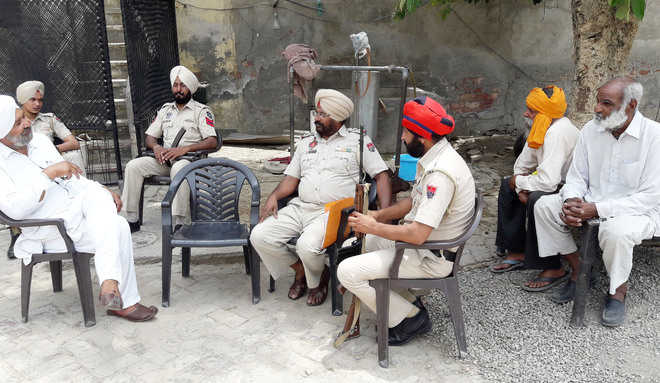 The police deployed at Bugha village on Wednesday. Tribune Photo
The police deployed at Bugha village on Wednesday. Tribune PhotoOur Correspondent
Tarn Taran, May 17A group of 25 men opened fire at an ex-serviceman in Bugha village, 6 km from here, yesterday. They were reportedly irked over his campaign against drug peddling.The injured, Subedar Surjit Singh (retd), has been admitted to a private hospital in Amritsar. He is said to be out of danger. His wife Kanwaljit Kaur was also injured in the attack.The armed men came to the village in three cars last evening. They forcibly entered Surjit’s house, allegedly thrashed and fired at him.Kanwaljit claimed that attackers were involved in drug trade. “They harboured a grudge against my husband as villagers led by him were raising voice against their illegal activity. They wanted to kill my husband,” she alleged.Goindwal Sahib DSP Satpal Singh said 25 persons had been booked, three of them by name, under Sections 452, 323, 324, 427, 336, 148 and 149 of the IPC, and the Arms Act.Those booked by name are Manjinder Singh Mani, Ajay and Sajan, all from Bugha village. “They are brothers and the prime accused in the case,” the police said.The police have been deployed in the village to prevent any untoward incident.
Nursing students adamant on principal’s ouster; protest on
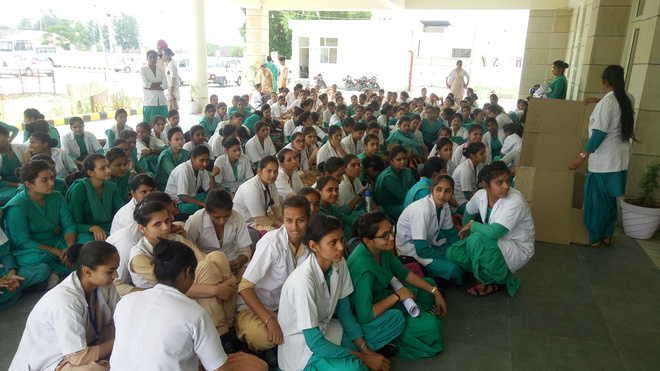 Nursing students hold a protest at the Civil Hospital in Gurdaspur on Wednesday. Tribune photo
Nursing students hold a protest at the Civil Hospital in Gurdaspur on Wednesday. Tribune photoTribune News Service
Gurdaspur, May 17
Stalemate between the agitating students and the GNM Nursing School Principal continued despite the intervention of the Deputy Commissioner (DC), who called a meeting of all stakeholders today.As many as 280-odd nursing students held a day-long protest inside the Civil Hospital. They demanded the dismissal of Principal Manjit Kaur claiming that she had questioned the character of injured student Veerpal Kaur.Veerpal had sustained a fracture following which her colleagues requested Manjit Kaur to arrange for treatment.The injured student has now been shifted to an Amritsar hospital. DC Amit Kumar said the administration would bear the cost of the treatment, while the students too collected money.The DC asked the three-member committee comprising Assistant Civil Surgeon Dr SK Hans and senior doctors Prabhjot Kaur Kalsi and Bhawna Lakhanpal to expedite the probe.“The committee has been asked to fix responsibility. The students have been asked to record their statements on basis of which the committee will prepare its report. The fate of Manjit Kaur will be decided based on the findings,” said the DC.Students’ spokesperson Navdeep Kaur said the stir would continue till the Principal was dismissed.
No water for five years, all hopes dry up
Residents of Dashmesh Nagar are dependent on water tankers sent by Municipal Corporation
Residents of Dashmesh Nagar are dependent on water tankers for their daily needs;
Nikhila Pant Dhawan
Tribune News Service
Bathinda, May 17
After waiting for more than five years, not only the water pipelines but also the hopes of residents of Dashmesh Nagar have dried up.Residents of this area located along the Naruana road are completely dependent on water tankers to meet their daily requirement even though their houses have water connections for the last five years.Voicing their disappointment, residents of street number 1 of Dashmesh Nagar, said all these years they had been facing acute shortage of potable water and are left with no option but to depend on water tankers sent by the Municipal Corporation Bathinda.“Despite having water connections, we have never got water supply. We have to call at the MCB office to get water tankers in the area. On an average, three tankers come to the street in a week and residents stock water for the rest of the days. All these years, we have brought our problems to the attention of several officials, but in vain,” said Karnail Singh.The situation is so abysmal that some residents have removed taps from the water pipes as they think the situation would not improve.Talking to Bathinda Tribune, Harjinder Singh, the councillor of the area, said the Sirhind canal was closed for a few weeks but even after the flow of water in the canal resumed, the water supply to his ward remained erratic.“I have brought the matter to the attention of Mayor Balwant Rai Nath and Water Supply Department SDO Darbara Singh. They have assured me of regular water supply soon,” he said.SDO Darbara Singh said he had yet not received any formal complaint pertaining to the water supply not reaching Dashmesh Nagar.He added that he would look into the issue and address it at the earliest.


















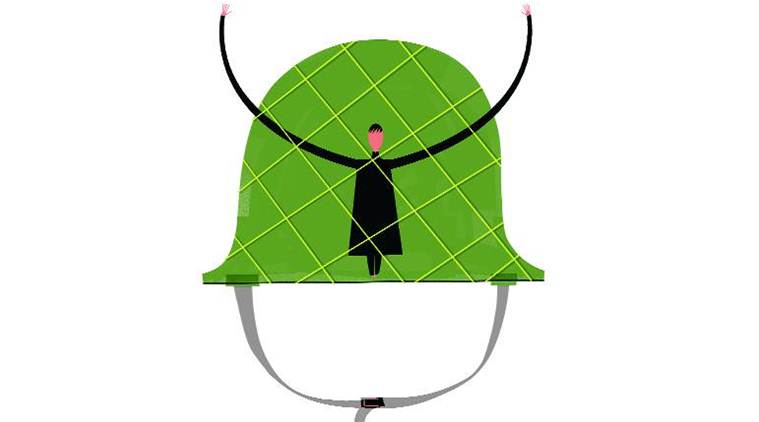 Major Gogoi’s decision to use Dar as a “human shield” is not about “a stand contrary to that of the majority”, as Amarinder Singh points out. (Illustration by -C R Sasikumar)
Major Gogoi’s decision to use Dar as a “human shield” is not about “a stand contrary to that of the majority”, as Amarinder Singh points out. (Illustration by -C R Sasikumar)